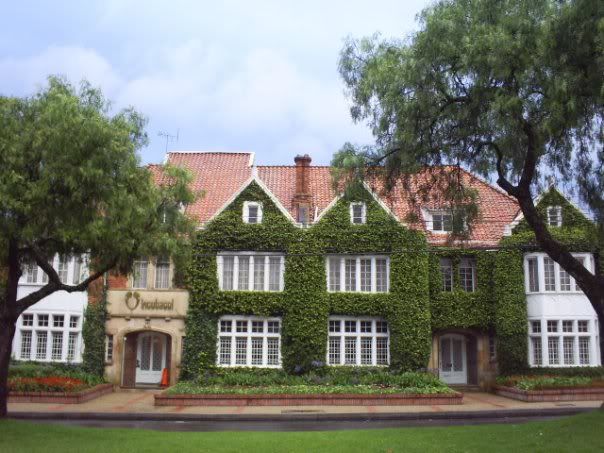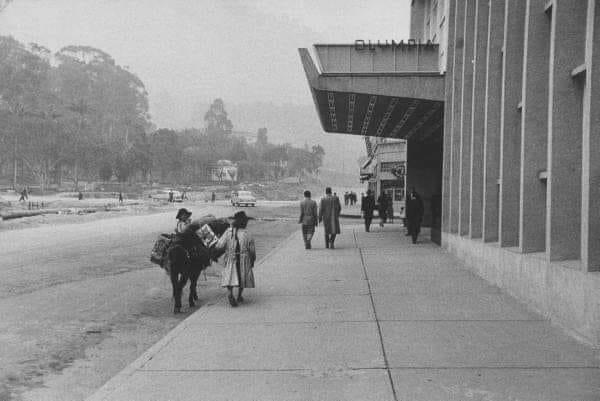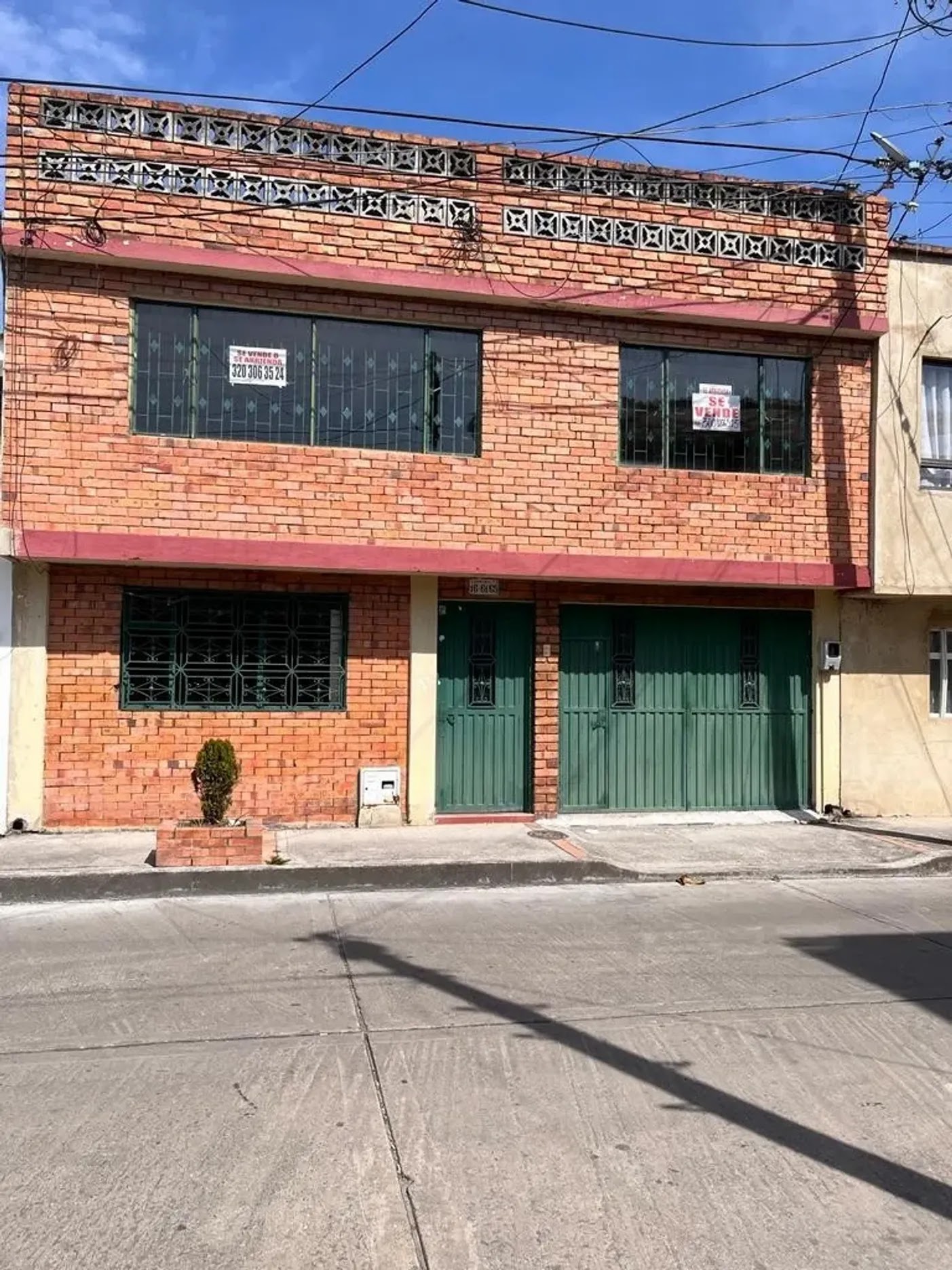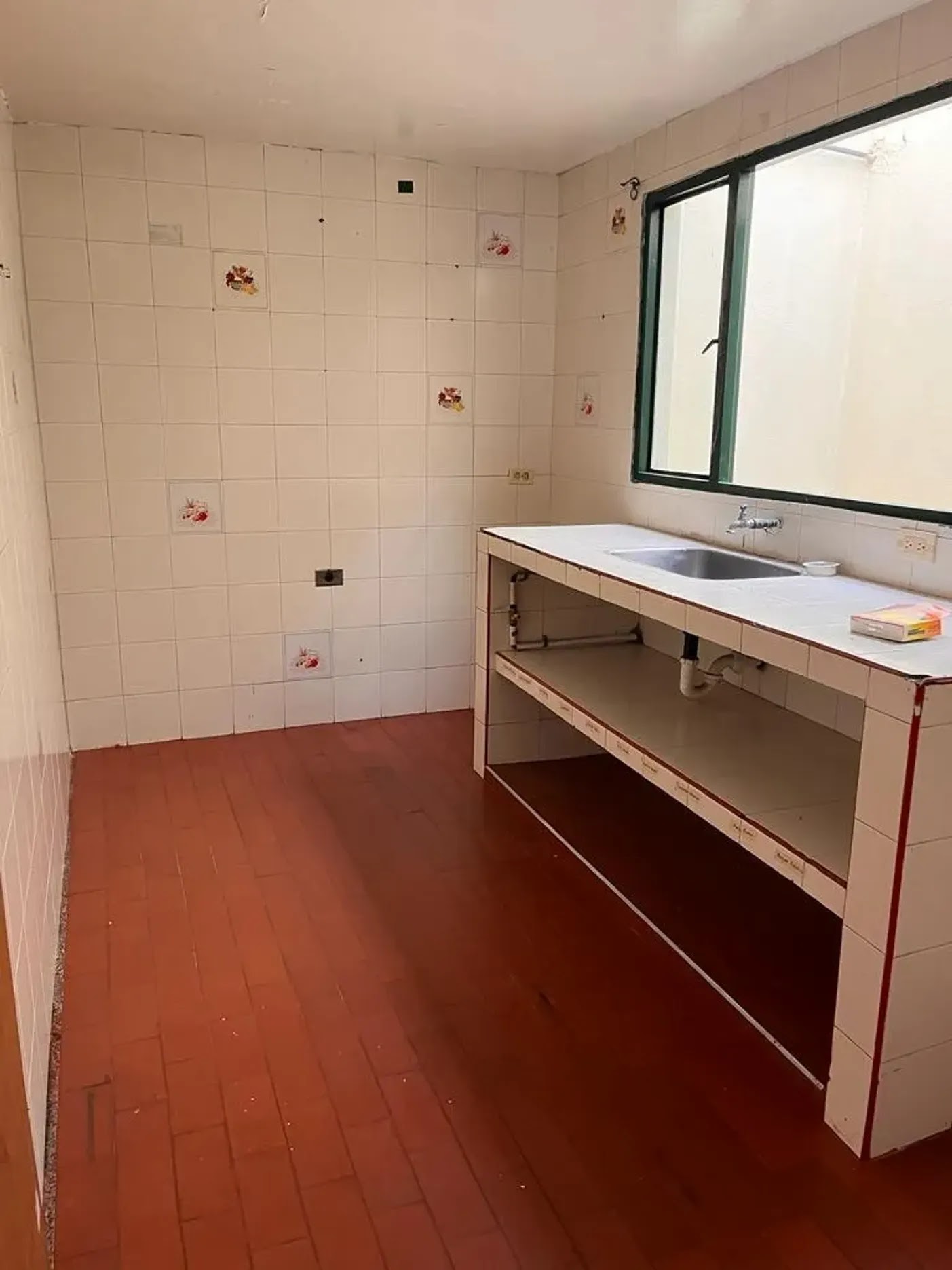So this post is so random, and I stole all these photos from all over the web. Lo siento. But, I just wanted to kind of give you a feel for Bogotá, because it's not really what people expect. This little train station was fairly close to where we lived (we technically lived in Usaquen, but almost into Los Cedros or Cedritos, a different neighborhood.)
It's original to the railroad being built in Colombia and there's a steam engine that takes tourists north to Chia from this station. The tickets were ridiculously expensive.
Here's the train back in the day when Usaquen was not a suburb to Bogotá and was its own little town.
Here's the tourist train now, I actually found it rather bothersome at times because I'd have to wait for it to cross the road while doing my grocery shopping.
Here's another building that always stuck out to me. I thought of the Death Star every time we passed this hospital. (We drove by it a lot.)
But it's actually really cool, it was designed to match the brick of the older buildings on the medical complex, but is made so natural light/air circulates and there's a 4 story tall garden/solarium inside.
And the brick provides insulation and cuts down on cooling and heating costs. Nifty eh?
Bogotá is interesting because there's all sorts of modern architecture scattered about but then there's tons of buildings that date back to the 1500 and 1600s. Maybe if I had travelled to Europe ever that wouldn't be so crazy to me. Or even Eastern US. But out in the western United States there is nothing that old. Okay, the Spanish settlements in Santa Fe and Tucson and San Antonio have old colonial buildings too. I take back what I said. Generally though, there's not much.
Leo and I spent some time by this cathedral one morning, we were of course running around trying to get my visa.
Also, Bogotá can be so colorful and charming, but is often described as grimey and dark, which is completely fair and accurate as well. I think the afternoon overcast skies don't help. It's always prettier in the morning when the sun is shining.
On the note of being colorful, it cracks me up that travel websites always show photos of the Mariposa neighborhood to advertise Bogotá, but yet it's a really impoverished area, and locals won't even go there for fear of being robbed/stabbed/left for dead. You get the idea. There are neighborhoods in Bogotá where I've heard that the police won't even go into, but I forgot which. Basically my rule of thumb was: don't go places where I don't know where I'm going and that it's safe. So no mindless wandering or exploring for me. As Leo's family pointed out, I'm far too gringa for that.
This photo is from the 1970's and it makes me think of Colombia even today, where there's so much modern mixed with so much...not modern? The first time I visited Bogotá in 2009, I remember seeing a horse pulling a wagon. I didn't see that in Bogotá itself this time, but you still see the handcarts pulled by the recycling workers all the time, etc. Such a crazy mix.
For instance, this park in downtown Bogotá--the first time I drove past it, what I noticed first was the smell of campfire, and I was so confused. Campfires in the middle of the downtown? But yeah, it's a refugee village filled with about 2,000 Emberá. "Here, along the buzzing Séptima, one of the city’s main North-South arteries, next to the Javeriana, a costly private university, and the city’s banking district, the Emberá have erected a city of improvised tents...". They're a indigenous tribe from Choco (a departmento/state) in Colombia that has some of the worst continuing violence, and they were driven out by cartels there, so they came to the capital city to protest and get help. It's been several years now and nothing has changed.
Another part of Bogotá that is a bit disparate, is the Chapinero neighborhood. I actually attended Spanish school in this area so I wandered through it quite a bit. (I may have missed my bus stop a couple of times). It's weird because well, let me quote an article, "Chapinero did not see significant urban development until the early 20th century, when an influx of migrants from rural areas led to the city’s expansion northward. This northern development aimed to accommodate the affluent segments of society. Coinciding with this growth was the advent of the Garden City movement in the UK and US, which greatly influenced urban planning in Chapinero. Designed to provide a tranquil residential area away from urban congestion, this concept promoted greenery, wide streets, and ample public spaces harmoniously integrated into the urban fabric.
Enter the stage Karl Brunner, an Austrian architect and urban planner who arrived in Bogotá in the 1920s. He was the mastermind behind this architectural transformation. Brunner’s vision for the city’s development included transforming its urban landscape to embrace modernity while preserving classic (north) European influences. Brunner was instrumental in laying out the plans and structure of many neighborhoods. His work is still evident today, as many buildings boast features such as gabled roofs, ornate wooden trimmings, and large bay windows made from local materials designed to mimic their European counterparts. Materials for these unique homes were carefully selected to emulate those used in traditional English manors, incorporating red brick facades, timber frames, and intricate ironwork."
https://xixerone.com/en/chapinero-and-zona-t-bogota/. Look, I cited my source this time.
Here's another article too.
https://markhillpublishing.com/philip-webb-british-architecture-in-bogota/ He talks about how "the amount of English-style buildings in the city stood out as unusual and weren’t found in any other South American city we had visited. These ranged from Victorian churches to light stone buildings that looked as if they had been lifted out of Oxford or Cambridge, to Arts & Crafts style houses, and even entire streets of what appeared to be suburban English houses from the 1910s-30s."
A tourist at my Spanish school brought it up one day as well. He said he felt he hadn't even left home half the time--he was staying in Chapinero and was from England.

Chapinero is the trendy, party place right now for tourists and foreigners. Most of the swankiest restaurants and bars are there, and most smart tourists stay there instead of the seedy (but more famous) Candelaria district. And most diplomats and foreigners live there as well. It's upper middle class so not excessively expensive, but more so than where we were in Usaquen. (Usaquen is also upper middle class but is mostly retirees and doesn't have the night life).
This is actually the Four Seasons Hotel where my bus stop was for the Spanish school. You should google the interior. It's gorgeous.
The REALLY uber rich areas of Bogotá are Rosales and El Chicó. Both kind of border Chapinero and Usaquen but are farther up in the mountains.
One time, Leo and I took an uber to go downtown to work on visa stuff and the driver drove through El Chicó (I think?) and Leo and I were both wide-eyed staring at all the beautiful houses. This photo above is actually not one of them--it's the El Chicó museum. But the area has a bunch of older Spanish style homes that are SOOOOO incredibly gorgeous!! You get the idea, even if this one is obviously not one of them.
The Rosales neighborhood has all these upscale apartment buildings and homes.
You can kind see how park-like all the surroundings are. Contrast that with a normal house in Bogotá where 95% of people live (that's my made up statistic).
You get the difference.
Here's the kitchen (which is quite big) for a lower middle class apartment.
And the living room. Again, quite big.
And the bathroom.
This is the Bosques, an area/apartments? just across the Carrera 7 from where we lived.
And here's a living room in the Bosques. Everyone always made the assumption that we lived in the Bosques because we lived near the Centro Comercial Palatino (again, right across the street), because they assumed we were uber wealthy being from the USA. Yeah, still solidly middle class here, thanks.
And another apartment near our townhouse in the Bosques. Granted, most people that came to our townhouse were like, your house is humongous!!! The lucky thing about our townhouse was that it didn't have a guard, so it was significantly less expensive than all the townhouses/apartments around it. Colombia has this thing where you pay taxes and utilities and school fees based on your home. Estato 6 was the highest class and paid the most, while Estato 1 is the lowest and don't pay much at all. According to one site, 80% of homes are 1-3, and only 3-4% of homes are 6 in Colombia. Ours was 4, because of the lack of a guard, while all around us was 5-6. And living in 1-3 isn't really an option for most foreigners because it likely won't be that safe.
But, yeah, Colombia is very classist and just by being below Carrera 7, we were definitely a different class. Living below Carrera 7 you'd never have this view, for one.
Anyway, here's a more pretentious house from one of the wealthier areas.
It's kind of old school decorated. I've seen some advertised there that are super modern and ultra trendy.
https://youtu.be/S7NPuqo2ph4?si=8UBtVUVMD8K-Cr5W Here's link to a video about Rosales and El Chicó (sort of--he goes to the mall and Juan Valdez, those are everywhere) but I do like how he films in Carulla's because that's where I shopped occasionally because one was half a block away and another really nice one like in his video was only two and half blocks away. Anyway, I'm documenting all of this, because so many people thought we were living in third world squalor and really have no idea how developed Bogotá is. It is the most developed South American city and really, Chapinero reminds me of Scottsdale, Arizona. Kind of the same vibe.
This reminds me of a lot of the more chic apartment buildings around Usaquen too. Just as a side note, most of the young families with kids that are upper middle class have moved even further north, to Chia and that area. Just FYI, if you were wondering.
This is more the typical upper middle class older Spanish style home that were around our neighborhood. They were old but so cool inside.
I love all the Spanish style furniture.
***If I could live anywhere in Colombia, it wouldn't be Bogotá or Chia (Chia is pretty though). I would buy a casa campestre (house in the country) in Subachoque.
I try to convince Leo all the time (despite having absolutely no money for it) to buy a house like this in Subachoque because #1--it's gorgeous, #2--Leo's family is from that area and I could haunt the parroquia in Subachoque till they caved and let me look through all their parish records, and #3 it's close enough to Bogotá to travel to easily.
I mean this house is over the top, but there's quite a few like this there because most of the upper class who can afford it in Bogotá DO have a casa campestre that they go to on the weekend.
I would of course bargain for the Great Danes too, because EVERY well off Bogotaño has a pure bred dog or three. 😉
And the countryside around Subachoque is SOOOOOO incredibly beautiful. I mean, look at that.
Anyway, it's beautiful, but really, I wouldn't want that big of a house, even in my dreams.
I'd want one like this in Subachoque.
I'd want one like this in Subachoque.
I love that just everything opens to the outdoors. And it's so charming.
Or look how cute this house is??! Okay, this one is sort of between Chia and Subachoque. But I love the red.
Anyway, that was my attempt at giving a different view of Bogotá. Hope it helped.























































No comments:
Post a Comment